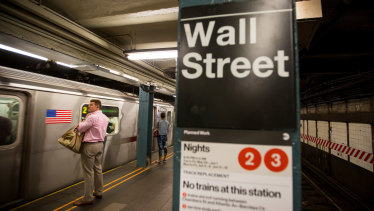New York subway’s pain could pay off in a big way for investors
You can make a lot of money betting on government bailouts.
Swooping in to buy the dirt-cheap stocks and bonds of troubled entities is a time-honoured — and profitable — tactic throughout the investing world. When deep-pocketed public saviours come forward, such a wager can pay off handsomely.

Given the vital role it plays in the economy of the nation’s largest city, the Metropolitan Transportation Authority, which runs New York’s subway, bus and commuter rail system, is a likely candidate for a lifesaving infusion of government cash.
“It’s very explicitly too big to fail,” said Matt Fabian, a partner at the research firm Municipal Market Analytics, who has been pitching MTA debt to his clients.
The agency was dealing with high costs even before the pandemic, and the beating the coronavirus has given its finances has raised the possibility of deep service cuts. That economic pressure is translating into low bond prices and some of highest — and therefore most tantalising — yields available to investors anywhere in the bond markets.
Investors who buy 10-year MTA bonds right now — the agency was expected to issue around $US258 million ($368 million) more in debt on Thursday (US time)— are capturing a yield of about 4 per cent. That’s roughly 3 percentage points more in annual interest than they would get buying the safest long-term municipal debt. It also trounces the yields of other major transit systems, which hover around 1 per cent.
If it were a for-profit corporation, the MTA would most likely be heading for bankruptcy. Its budget deficit has exploded, and last week Fitch downgraded the agency’s bond rating, citing weak ridership and revenue outlook.
But the MTA is a quasi-governmental body — technically a public benefit corporation, formed in 1968 — that’s deeply entwined with the economic health of the region. That means its risk of default is almost infinitesimal, investors and analysts say.
There’s another reason to like these bonds: federal and state tax exemptions on municipal debt. To match the after-tax return on MTA bonds without taking on a lot more risk, analysts say, investors would need to find relatively safe corporate bonds yielding almost 9 per cent — all but nonexistent nowadays.
Len Templeton, president of Templeton Financial Services in Arizona, has allocated roughly 5 per cent of his client assets to the securities issued by the MTA. He said he couldn’t imagine the agency’s being allowed to default.
“I mean, how could you not think they should have public transportation in a city like New York?” asked Templeton, who manages some $US425 million in client assets in bond funds. “And how can the city survive and do what it needs to do without it?”
Even Fitch, in downgrading the agency’s rating to A– from A+, said the MTA continued to have “the highest strategic and economic importance” and would continue to benefit from government support.
Mark Paris, who manages New York and national municipal bond funds for the asset management firm Invesco, said MTA bonds were “definitely a great place to get some yield.” He has been adding them to his holdings, but warned of violent swings in their prices as the agency struggles to stabilise itself over the next few years.
“Is there going to be volatility?” he said. “Yes.”
In fact, there already has been quite a bit. Prices for MTA bonds are normally quite stable, but as the virus gripped New York in March and April, they plunged more than 20 per cent and sent yields shooting up.
In normal times, the MTA’s massive ridership is a stabilising force: Subway, commuter train and bus fares, as well as bridge and tunnel tolls, matched 50 per cent of the operating costs in 2019.

“It’s a strength because it reduces their reliance on statewide and citywide politics,” Fabian said.
That strength disappeared with the arrival of the pandemic. Subway ridership — averaging around 5.5 million on weekdays last year — collapsed more than 90 per cent as a result of widespread shutdowns intended to limit the spread of the virus, which was killing more than 500 people a day in the city. Even with infection rates well down from their peak, subway ridership is still 70 per cent below last year’s level.
And that means the MTA needs money — badly. Before the pandemic, the agency projected an estimated surplus of $US270 million for 2021. Now? It is projecting a deficit of roughly $US5.8 billion. Its annual deficit is expected to add up to about $US16 billion by 2024.
While investors and analysts expect that financial help will materialise, exactly where it will come from and when it will arrive aren’t clear.
The agency, which already received $US4 billion under the CARES Act, is asking for some $US12 billion in emergency aid from the federal government to make it through next year. But talks in Washington have been stuck in neutral from months.
If Democrats capture both the White House and the Senate next week, most observers predict the federal government will come through with more help. But even if Republicans retain control in Washington, that won’t be the end of the line for the MTA. Rather, investors believe that would just force the state to cough up the money the agency needed.
“The expectation is the State of New York can and will support the MTA if additional federal moneys aren’t forthcoming,” said Howard Cure, director of municipal bond research at Evercore Wealth Management in New York.
There’s a simple reason: New York City is the economic engine of the state, providing nearly half its jobs. By itself, Wall Street — the securities industry centred in Manhattan — accounts for roughly 17 per cent of the state’s tax revenues. The state simply can’t afford not to keep the MTA running and New York City functioning.
The New York Times
Business Briefing
Start the day with major stories, exclusive coverage and expert opinion from our leading business journalists delivered to your inbox. Sign up for the Herald‘s here and The Age‘s here.
Most Viewed in Business
Source: Thanks smh.com